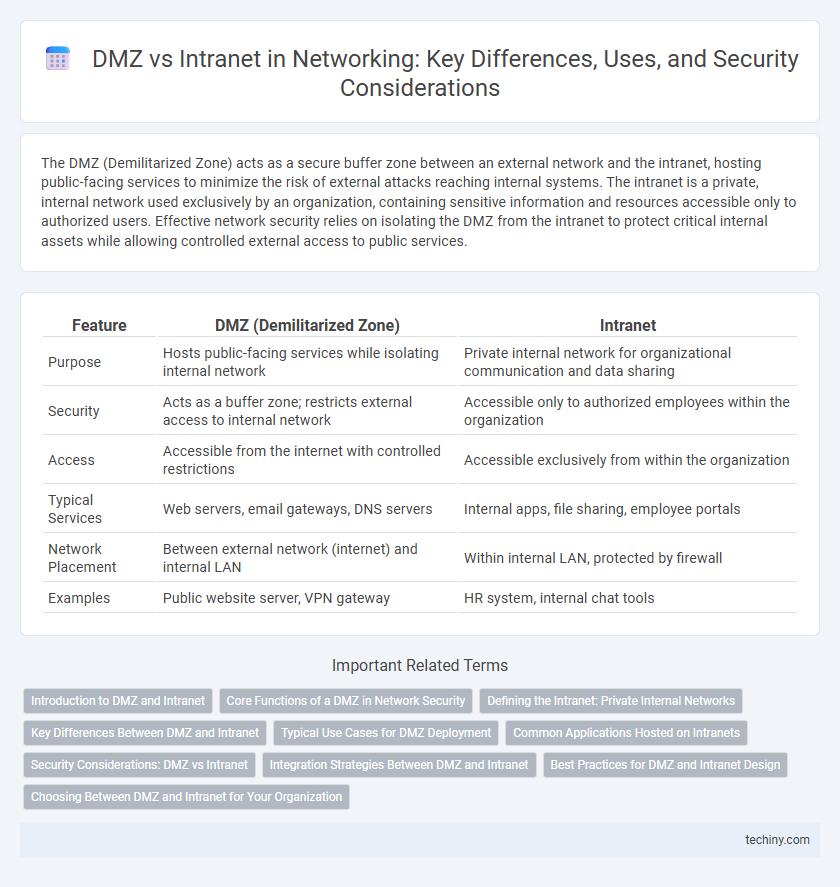The DMZ (Demilitarized Zone) acts as a secure buffer zone between an external network and the intranet, hosting public-facing services to minimize the risk of external attacks reaching internal systems. The intranet is a private, internal network used exclusively by an organization, containing sensitive information and resources accessible only to authorized users. Effective network security relies on isolating the DMZ from the intranet to protect critical internal assets while allowing controlled external access to public services.
Table of Comparison
| Feature | DMZ (Demilitarized Zone) | Intranet |
|---|---|---|
| Purpose | Hosts public-facing services while isolating internal network | Private internal network for organizational communication and data sharing |
| Security | Acts as a buffer zone; restricts external access to internal network | Accessible only to authorized employees within the organization |
| Access | Accessible from the internet with controlled restrictions | Accessible exclusively from within the organization |
| Typical Services | Web servers, email gateways, DNS servers | Internal apps, file sharing, employee portals |
| Network Placement | Between external network (internet) and internal LAN | Within internal LAN, protected by firewall |
| Examples | Public website server, VPN gateway | HR system, internal chat tools |
Introduction to DMZ and Intranet
DMZ (Demilitarized Zone) in networking is a physical or logical subnetwork that separates an internal local area network (intranet) from external networks, typically the public internet, enhancing security by isolating external-facing services. The intranet is a private, internal network accessible only to an organization's members, designed to facilitate secure communication and resource sharing within the enterprise. Implementing a DMZ ensures that external users can access specific services without exposing the intranet, minimizing the risk of unauthorized access to sensitive internal data.
Core Functions of a DMZ in Network Security
A DMZ (Demilitarized Zone) in network security serves as a buffer zone between an internal intranet and untrusted external networks, such as the internet, protecting sensitive internal systems from direct exposure. Key functions include hosting publicly accessible services like web servers, email servers, and DNS servers while preventing external threats from reaching the intranet. This segmented network architecture enhances security by isolating potential breaches and controlling traffic flow through firewalls.
Defining the Intranet: Private Internal Networks
An intranet is a private internal network used within an organization to securely share information, resources, and applications among employees. Unlike a DMZ, which serves as a buffer zone between the internal network and external threats, the intranet is designed exclusively for internal communication and collaboration. It enhances productivity by providing controlled access to corporate data and services while maintaining strict security protocols.
Key Differences Between DMZ and Intranet
A DMZ (Demilitarized Zone) in networking is a secure zone that separates an internal local area network (LAN) from untrusted external networks, typically hosting public-facing servers such as web, mail, and DNS servers, to enhance security. In contrast, an intranet is a private network accessible only to an organization's internal users, facilitating secure communication and resource sharing within the company. The primary difference lies in the DMZ's role as a buffer zone exposed to external traffic with strict access controls, whereas the intranet is an internal network environment designed for confidential and efficient internal operations.
Typical Use Cases for DMZ Deployment
DMZ deployment is typically used to host public-facing services such as web servers, mail servers, and DNS servers, isolating them from the internal intranet to enhance security. It provides controlled access for external users while preventing direct access to sensitive internal resources, reducing the risk of breaches. Organizations implement DMZs to safely handle internet traffic and maintain a secure boundary between public networks and private intranet environments.
Common Applications Hosted on Intranets
Intranets commonly host applications such as internal communication tools, employee portals, document management systems, and enterprise resource planning (ERP) software, enabling secure and efficient collaboration within an organization. Unlike DMZ environments that expose services like web servers and email gateways to external networks, intranets provide a protected space for sensitive business operations and confidential data management accessible only by authorized personnel. These internal applications facilitate streamlined workflows, centralized information access, and enhanced productivity while maintaining strict access controls.
Security Considerations: DMZ vs Intranet
DMZs enhance security by isolating public-facing services from the internal intranet, reducing exposure to external threats and limiting attack vectors. Intranets prioritize internal communication and data exchange within an organization, demanding stringent access controls and monitoring to protect sensitive information. Implementing firewalls and segmented network zones between DMZ and intranet strengthens defense-in-depth strategies and prevents lateral movement of attackers.
Integration Strategies Between DMZ and Intranet
Integration strategies between DMZ and intranet typically involve the implementation of secure gateway devices such as firewalls and proxy servers to control access and enforce strict security policies. Network segmentation and access control lists (ACLs) ensure that only authorized traffic flows between the DMZ and intranet, minimizing attack surfaces and preventing lateral movement of threats. Utilizing VPNs and secure tunneling protocols further strengthens communication channels by encrypting data and maintaining confidentiality between exposed public services in the DMZ and sensitive internal intranet resources.
Best Practices for DMZ and Intranet Design
Effective DMZ and intranet design requires strict segmentation to enhance security by isolating public-facing services from internal networks. Implementing granular access controls, such as firewalls and intrusion detection systems, ensures that only authorized traffic passes between the DMZ and intranet environments. Regularly updating security policies and conducting vulnerability assessments further strengthen defenses, minimizing risks associated with unauthorized access and data breaches.
Choosing Between DMZ and Intranet for Your Organization
Choosing between a DMZ (Demilitarized Zone) and an intranet depends on your organization's security needs and network architecture. A DMZ provides a buffer zone between the public internet and the internal network, ideal for hosting public-facing services while protecting sensitive data. In contrast, an intranet is a private network restricted to internal users, offering enhanced confidentiality and streamlined communication within the organization.
DMZ vs Intranet Infographic

 techiny.com
techiny.com